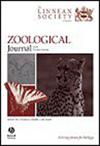A holistic perspective on species delimitation outperforms all methods based on single data types in freshwater gastropods (Caenogastropoda: Hydrobiidae: Pseudamnicola)
IF 3
2区 生物学
Q1 ZOOLOGY
引用次数: 0
Abstract
Freshwater gastropods are one of the most species-rich and severely threatened animal groups in continental aquatic ecosystems. Unfortunately, understanding their species diversity, which is key to conservation, is often hampered by their small size, simple morphology, and restricted distribution. This is particularly the case for spring snails of the genus Pseudamnicola (family Hydrobiidae), a species-rich taxon across the Mediterranean region. Contrasting species diversities derived from molecular phylogenies and traditional taxonomy call for a holistic approach, in which molecular markers are used to identify putative taxonomic units that can then be validated morphologically. We integrated DNA sequence and morphometric data from 92 populations into a species delimitation framework to assess the taxonomic status of 25 nominal and 14 informally recognized species of Pseudamnicola across its geographical range. Although seven discovery methods delimited a varying number of putative species, taking an integrative approach generally improved species support over single datasets. The statistically favoured integrative scheme corroborated 30 of the 39 initial species as separate entities, whereas nine require taxonomic re-evaluation. Six species are described here formally. Pseudamnicola exemplifies the importance of considering multiple lines of evidence to evaluate species diversity in taxonomically complex groups, with newly developed approaches providing the needed toolbox.淡水腹足类(腹足纲:水螅科:伪鳞目)物种划分的整体视角优于所有基于单一数据类型的方法
淡水腹足类是大陆水生生态系统中物种最丰富、受威胁最严重的动物群体之一。遗憾的是,由于它们体型小、形态简单、分布范围有限,了解它们的物种多样性(这是保护的关键)往往受到阻碍。地中海地区物种丰富的假蜗牛属(Hydrobiidae 科)春蜗牛的情况尤其如此。通过分子系统发育和传统分类法得出的物种多样性对比要求采用一种整体方法,即使用分子标记物来确定假定的分类单元,然后再从形态学角度进行验证。我们将来自 92 个种群的 DNA 序列和形态计量学数据整合到一个物种划分框架中,以评估整个地理范围内 25 个标称种和 14 个非正式认定种的分类地位。尽管七种发现方法划分了不同数量的推定物种,但与单一数据集相比,综合方法普遍提高了物种支持率。从统计学角度来看,综合方案支持了 39 个初始物种中的 30 个物种,而 9 个物种则需要重新进行分类评估。这里正式描述了六个物种。假滇金丝猴(Pseudamnicola)体现了考虑多种证据来评估分类学上复杂类群的物种多样性的重要性,新开发的方法提供了所需的工具箱。
本文章由计算机程序翻译,如有差异,请以英文原文为准。
求助全文
约1分钟内获得全文
求助全文
来源期刊
CiteScore
6.50
自引率
10.70%
发文量
116
审稿时长
6-12 weeks
期刊介绍:
The Zoological Journal of the Linnean Society publishes papers on systematic and evolutionary zoology and comparative, functional and other studies where relevant to these areas. Studies of extinct as well as living animals are included. Reviews are also published; these may be invited by the Editorial Board, but uninvited reviews may also be considered. The Zoological Journal also has a wide circulation amongst zoologists and although narrowly specialized papers are not excluded, potential authors should bear that readership in mind.

 求助内容:
求助内容: 应助结果提醒方式:
应助结果提醒方式:


